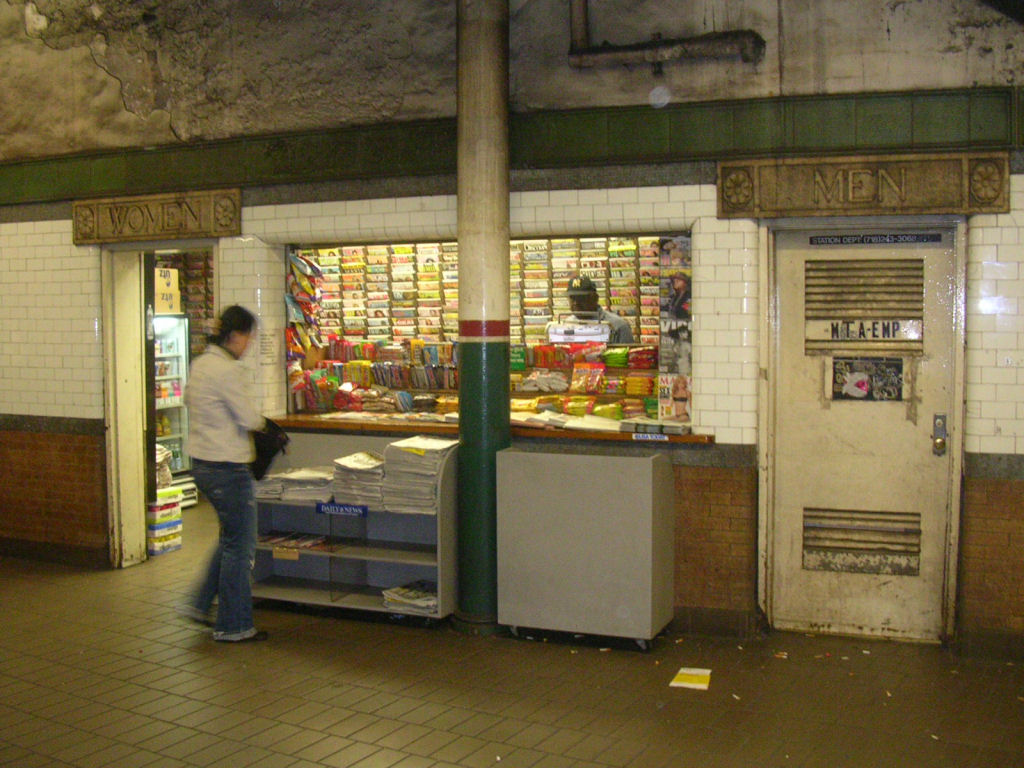Once a bathroom; now a newsstand. (Photo by flickr user theratrace)
A few weeks ago, I was heading back to Park Slope from Manhattan and found myself on a D train. To get home, I had to switch at Atlantic/Pacific to a train that makes local stops, and I thought I’d use the time I had to duck into the bathroom. It was during the middle of the afternoon rush, and I assumed that bathrooms on the mezzanine between the Fourth Ave. stop at Pacific St. and the IRT platforms at Altantic Ave. would be open. Luckily for my olfactory sense, the bathroom was locked even though the sign said it would be closed only from midnight to 5 a.m., and I simply waited until I arrived home a few minutes later.
Around the subway system, the MTA’s bathrooms pop up like hidden gems – or trash heaps – amidst an unfriendly system. New York isn’t known for its public restrooms, and the subways are no exception. The johns at Times Square near the 8th Ave. line are useable; the ones at W. 4th St. are generally locked; and I don’t know anyone who dares enter the restrooms on the F platform at Delancey St. You never know what you’re going to find.
For a few years, I’ve toyed on and off with a subway bathroom feature. I’d take my camera and document the toilets underground. Somehow, though, I haven’t been able to stomach the idea. Do we really want to see what’s inside the subway’s myriad unloved bathrooms? Today, Heather Haddon did just that sans a camera. She explored all 129 restrooms in 77 subway stations and found what you would expect. Most are dirty; most reek of human waste; and nearly half of them were closed when they should have been open. “They’re pretty disgusting. People are always cleaning themselves in there and doing other stuff,” Kelvin Pau said at 168th St.
Haddon continues:
Of the open bathrooms, a third were frightening caverns of garbage, urine, standing water or unseemly smells. Odors from the Astoria-Ditmars Blvd. station on the N nearly caused an amNewYork reporter to feel faint during a recent visit…
Don’t expect to find toilet paper or soap, as few of the bathrooms had either. And while graffiti has largely been eliminated from subway stations, it lives on in the bathrooms, as many of the walls and stalls were covered in tags.
Keeping the bathrooms tidy and open is a challenge because they are constantly being vandalized or attract “criminal activity,” Seaton said. “They may be locked at any given time due to vandalism and ongoing repairs,” he said.
Haddon and her co-reporter Nicholas Klopsis close with a list of the best and worst bathrooms in the system. Stay away from Hunts Point where the men’s room stalls have no walls or 57th St. and Broadway with its “potpourri of not-so-pleasing smells.” And if you really have to go, just head above ground and find the nearest coffee house. It can’t be worse than the restrooms that mar the subways.


 Even as Phase 1 of the Second Ave. Subway moves forward, the Holy Grail of New York City subway expansion plans is still inspiring those who dream of a better mass transit system for the city. Over at his excellent site vanshnookenraggen, Andrew Lynch recently unveiled his incredibly fascinating and thorough
Even as Phase 1 of the Second Ave. Subway moves forward, the Holy Grail of New York City subway expansion plans is still inspiring those who dream of a better mass transit system for the city. Over at his excellent site vanshnookenraggen, Andrew Lynch recently unveiled his incredibly fascinating and thorough 

















 Since the stabbing that left two people dead on a downtown 2 train nearly two weeks ago, much has been written about the MTA’s inadequate surveillance camera system. We know that the MTA and Lockheed Martin are in a legal battle over a system that hasn’t been implemented properly, and we’ve explored the
Since the stabbing that left two people dead on a downtown 2 train nearly two weeks ago, much has been written about the MTA’s inadequate surveillance camera system. We know that the MTA and Lockheed Martin are in a legal battle over a system that hasn’t been implemented properly, and we’ve explored the  This past Sunday night, I found myself on a reasonably crowded 2 train heading from the Upper West Side to Park Slope. As the train went local and slowly snaked its way down the West Side, I had ample opportunity to surreptitiously survey the scene. What struck my fancy was something quite disgusting.
This past Sunday night, I found myself on a reasonably crowded 2 train heading from the Upper West Side to Park Slope. As the train went local and slowly snaked its way down the West Side, I had ample opportunity to surreptitiously survey the scene. What struck my fancy was something quite disgusting.